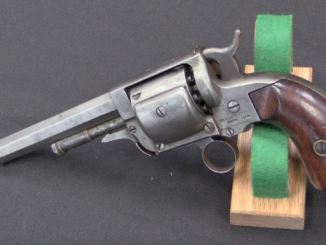Lot 259 in the September 2019 RIA auction.
Patented by Austin H. Freeman in 1862, 2000 of these revolvers were manufactured by Hoard’s Armory in Watertown New York in 1863 and 1864. None were purchased by the Federal government, but they were sold to states and private individuals, and saw use in the Civil War. Freeman’s patent was for an interesting cylinder removal mechanism, in which a sliding latch allows the cylinder and axis pin to slide out the right of the frame as a complete unit, quickly and easily. Otherwise, the Freeman is a fairly typical Army-type revolver, with a .44 caliber bore, 6-shot cylinder, single action mechanism and 7.5 inch barrel.



That takedown mechanism may have been the inspiration for the Ruger cap and Ball replica. Its spindle and loading lever come out in a similar fashion
That spring is very similar to the Colt 1877 trigger spring.
I detect quick reloading cowboy movie action!
“He’s six and out! Get him!” Bang! “No, he got me!”
Just kidding!
In France the rugar stainless steel cap and ball revolver has been classed the same as a modern cartrige revolver due to its innovative mechanisme. This shows that in reality there is nothing new avec du vieux on fait du neuf
There is really nothing new under the sun. The problem is that a cap-and-ball revolver cylinder, even if removable from the revolver, requires more loading actions than shoving brass cartridges into the cylinder. Powder must be poured into the chambers from the front of the cylinder and the bullets (plus wadding) must be hammered into the chambers afterwards. Percussion caps are applied after that, and only one at a time. And above all, revolver cylinders do NOT come cheap (lots of drilling and milling operations here)! Feel free to correct me if I’m totally off the mark.
That’s a nice looking gun, and better designed than the 1861 Colt due to the solid frame.
The Freeman revolver was the “intermediate step” between the Rogers & Spencer and the earlier Pettengill double-action-only (DAO) revolver. See “The Pettengill Percussion Army Revolver and its Sibling”;
http://www.cliffhangershideout.com/gazette/2006/jun06.html
The main thing which distinguishes the Freeman from its two siblings is its round barrel as opposed to the octagonal barrels of the earlier Pettengill and later R&S. Other than that, and the Freeman’s cylinder latch, from the front face of the cylinder forward the three are essentially identical.
Actually, the Freeman and thus the Rogers & Spencer’s grip shape probably were copied from the Starr revolver, the early double-action model to be exact. It’s certainly easier to get a correct grip on than the Pettengill’s, which seems to have been mostly inspired by European hammerless pepperbox revolvers of the Mariette type.
Most people forget (or else just never knew) that the single-action Starr revolver was the Second Model. The First Model was the double-action version, and in 1863 the Union Army asked Starr to change to a simpler (and less expensive) single-action lockwork, both to reduce cost and also because almost every other revolver in common use (Colt, Remington, etc.) was a single-action. Yes, this simplified training and reduced ADs.
Starr complied, and as a result the single-action Second Model accounted for about two-thirds of total Starr revolver production from 1860 to 1865.
It could be argued that the Second Model Starr, other than its hinged-frame system inherited from the First Model, was largely copied from the Freeman, rather than the other way around.
cheers
eon